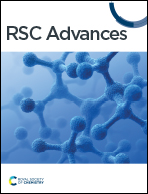Performance and mechanism of a bioelectrochemical system for reduction of heavy metal cadmium ions†
Abstract
This study explores the removal of Cd(II) from wastewater using a microbial electrolysis cell (MEC) to investigate the electrochemical performance and removal kinetics of an anodic polarity reversal biocathode and the mechanism of action of electrochemically active bacteria. Comparative electrochemical methods showed that using an anodic polarity reversal biocathode resulted in greater than 90% removal of different concentrations of Cd(II) within three days, which may be related to the catalytic effect of anodic electrochemically active bacteria. However, due to the ability of bacteria to regulate, up to nearly 2 mg L−1 of Cd(II) ions will remain in solution. As shown by the linear fitting relationship between scanning speed and peak current, the removal process was dominated by adsorption control for 20–80 mg L−1 Cd(II) and diffusion control for 100 mg L−1 Cd(II). The analysis of raw sludge and sludge containing Cd(II) showed that Arcobacter and Pseudomonas were the primary cadmium-tolerant bacteria, and that the ability to remove Cd(II) was the result of a synergistic collaboration between autotrophic and heterotrophic Gram-negative bacteria.



 Please wait while we load your content...
Please wait while we load your content...